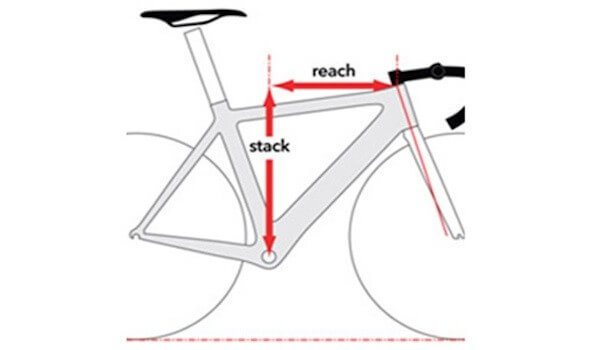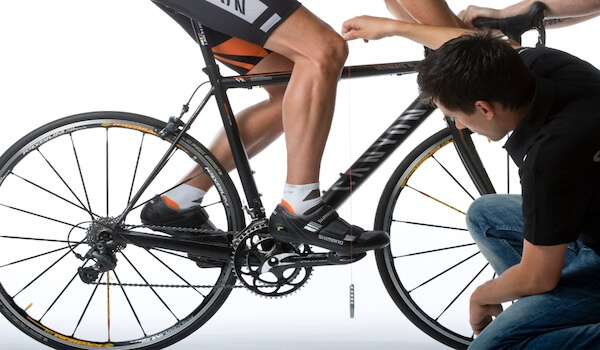 There are many components of a proper bike fit, each of which are important for a comfortable, injury free ride. Often times the reach to the handlebars is neglected which can drastically change the way a bike rides and can create painful areas on the body, particularly in the back.
There are many components of a proper bike fit, each of which are important for a comfortable, injury free ride. Often times the reach to the handlebars is neglected which can drastically change the way a bike rides and can create painful areas on the body, particularly in the back.
Getting a proper bike fit including the correct reach to the bars will allow you to get the most out of your ride and leave you feeling great after as well.
Starting with the Seat Position
The position of the seat on a bike is the easiest part that can be adjusted to get a good fit. A proper seat height leaves you with a slight bend in your knee at the bottom of your pedal stroke. A good gauge is to put your heel on the pedal and stop at the bottom of the pedal stroke without rocking your hips to that side. Your heel should just touch the pedal or be slightly above. This will get you close to where you should be. Some fine tuning will still be required.
Fore/Aft Seat Position
The second part of the seat adjustment that is often forgotten is how far forward or back the saddle is. An easy way to judge where this should be is to sit normally on the seat and spin backwards and stop with one of your legs positioned at 90 degrees, in other words the pedal should be at the 3-o’clock position.
Using a plumb bob, the front of your knee cap should fall directly over the spindle of the pedal.

If it’s not close, adjust the seat forward or backward as needed. This is a fairly easy adjustment as well which can be achieved by loosening the bolts underneath the seat on the seat rails. This will allow the seat to slide forward and back. Also, you will be able to adjust the levelness of the seat while doing this. Typically you want a level saddle.
Handle Bar Height
Now we get to the height of the handle bar. This is going to depend on the type of riding that you’re doing and how aerodynamic you wish to be. In general, around town you will have more of an upright position. On the road you want a lower, more aerodynamic position while mountain biking falls somewhere in-between. With this, you also need to test your flexibility in order to determine what handlebar height is appropriate for you.
If the backs of your legs and back are too tight, you simply won’t be able to comfortably get into a lower position so bringing your bars up is the only option. To raise and lower your bars you need a little bit more know-how than for the saddle position. As long as you have enough room on your steerer-tube, the top part of your fork that the handle bars attach to, you can move the spacers above or below the stem. If this isn’t enough you can get a different stem that has an angle that brings you to your proper position.
Handle Bar Reach
The final part in handle bar reach is the reach itself to the bars. A good way to gauge this is to get on the bike in your normal position and look down at the axel of the front wheel. Where do the handlebars fall relative to the axel in your line of sight? If the axel is behind the handle bars by more than an inch, the bars are stretched out too far. If the axle falls ahead of the bars, you are too scrunched and need to push the bars out a little. The only way to achieve this proper reach is to change the length of your stem provided you have already moved your saddle to its proper height and fore/aft position.
It is important to note that you must adjust your saddle position and handle bar height first and THEN handle bar reach.
Why Reach is Important
Getting the proper reach may be a bit more involved than adjusting where the saddle goes but it is still just as important. A bike with handlebars too far forward or back will ride differently particularly if you’re on a mountain bike. You can’t make turns and handle the bike as quick and easily and overall it will feel clumsy. Along with this, as well as if the bars are particularly too low, your back will have to adjust to make up for it which on a short ride you may not notice but after a longer ride, those muscles are going to become strained. Having the proper reach is an easy way to avoid pain which will keep you out on the road or trails.
The best way to get the proper reach to the bars is to have your position looked at and changed as soon as you get the bike. If it’s from a shop, they can easily get you properly fitted with any changes that may be needed. If you already have been riding the bike and think it needs some adjustment, don’t wait. Get the fit correct as soon as you can as it is much easier to avoid an injury than recovering from one and trying to correct the cause of it. A bike is an incredible tool but not having it perfectly in sync with you takes away from the way it rides as well as how you feel on it. Get it dialed now and your riding will thank you for it.